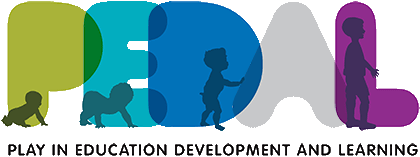When it comes to play, we often think about toys, games, and running around outside. But can we play with books? This is a question we’re currently exploring in the PEDAL Centre. Today we want to share some of our top tips with you from our Playtime with Books project, which is funded by the Nuffield Foundation.
Research looking into child development and the ways that we can support families with young children has shown that books can be a fun and simple focus of play. Book sharing activities can provide close moments with your children, with the shared interest of the book helping you and your child to become more ‘in sync’ with one another.
What is book sharing?
Book sharing is an engaging activity where adults play and spend time with children using books. It isn’t about reading the book, but rather using the book itself, and the words and pictures inside, to be playful. Like other kinds of play children often love, book sharing gives children the freedom to take the lead and explore the book however they want. For younger children, you might find your child enjoys turning books upside down, batting the pages, and flipping them back and forth – this is them exploring the book like they do lots of other toys and objects. Very young children may even like to explore the book with their mouths! As they get older, younger children will become more interested in the words, pictures and the overall story of the book. Bright, fun, and textured pictures can grab children’s attention as they are really fun to look at and help children learn about new objects and words.
Why is book sharing good for children?
Book sharing provides a great opportunity for you and your child to spend time together, focusing on and thinking together about the same thing. This quality time, away from the rush of daily life, can be a nice way of showing your child just how important they are to you.
Research has shown that book sharing is particularly good for young children’s language development. All the words and pictures inside books provide a rich opportunity for your child to learn about different objects, people, colours, and whatever else the book gets you both talking about. Book sharing also helps us to talk about the emotions and feelings that the characters in the book are expressing, helping children to understand and learn the names of those feelings.
Book sharing can also help children’s thinking, attention, and memory skills (their cognitive development). Sharing books together can help your child to direct their attention to what you’re showing them, to stay focused on it and talk about it, and to find ways to show you what’s interesting to them. As children start to engage more with the book’s story, their thinking skills will also improve as they start wondering about what is happening in the book and what might happen next. By talking about the book with your child, you help them to remember the content of the book and also to make links between the story and your own family life.
We think that book sharing may also help to support social emotional development. Picture books include lots of different characters such as young children and animals, and this provides a really good opportunity to talk and think about the actions and thoughts of these characters.
This is really important for young children to learn about and understand that other people have different thoughts, feelings, and experiences to them.
How can you book share with your child?
Although book sharing activities may differ depending on your child’s age, the most important thing to remember is to follow their lead – let them set the pace and show you what they’re interested in. Let your child have freedom with the book and hold it as they like! Don’t worry if they are holding it upside down or working through it backwards – the main goal of playtime with books is to support your child in exploring the book any way they like, rather than teaching them “conventional” reading with books.
Sit closely to them so that you can see what your child is interested in. When they show they are interested in something in the book (e.g., by looking, pointing, babbling in excitement), point to it and name it. You can also build on what you say to help your child learn more about what you’re looking at. For example, “oh look at the monkey! Monkeys like to eat bananas and climb up tall trees!” You can use actions to do this as well. For example, if the characters in the book are bouncing on a trampoline, you can bounce your child up and down on your leg.
You can also repeat any words or word attempts that your child makes – try to avoid telling them that they are wrong if they incorrectly label or vocalise something. Show them that you understand what they are saying and gently support them to learn the right label or how to say it. For example, if your child points to a cat in the book and says “doggy!”, you could say “that’s right! That’s an animal, like a dog, this one is called a cat!”.
Link the book content to things that your child knows and can understand. For younger children (under 12 months), you could link to something right then and there in the moment – “look the little boy is wearing socks! Here are your socks!”. For older children (1 year+), you could link to something that they have experienced before and are able to remember – “the little girl is going to the shops with her daddy! We went to the shops yesterday and bought lots of things!”.
Using and exaggerating your facial expressions and tone of voice can really help your child to learn about emotions. Label the feelings that characters in the book are experiencing and talk to your child about a time when they might have felt the same to help them understand what the character is feeling and why.
Ways to start book sharing
Setting up a daily routine, even a short one (5 to 10 minutes), could help you and your child get into the habit of engaging in shared activities. Look out for a time in the day when your child is not tired and hungry, and where you can spend some time with them.
Find a space where distractions are at a minimum, for you and your child. Turning off the television or tidying away toys and digital devices can help the two of you settle in and focus on the activity.
Playtime with books can allow you and your child to share lovely moments, where you can focus on one another and have fun. Sitting side-by-side or with your child on your lap can not only help your child to playfully explore the book, but also make them feel extra close to you!

Relevant articles
- Shared Picture Book Reading Interventions for Child Language Development: A Systematic Review and Meta‐Analysis. (Dowdall, Melendez-Torres, Murray, Gardner, Hartford, & Cooper, 2020)
- Psychosocial effects of parent-child book reading interventions: A meta-analysis. (Xie, Chan, Ji, & Chan, 2018)
- Randomized controlled trial of a book-sharing intervention in a deprived South African community: Effects on carer-infant interactions, and their relation to infant cognitive and socioemotional outcome. (Murray, De Pascalis, Tomlinson, Vally, Dadomo, MacLachlan…Cooper, 2016)

Tilly Kirby
PEDAL PhD student

